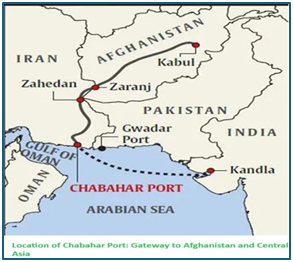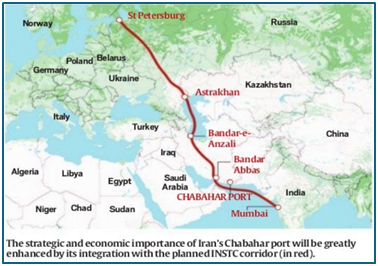Why in news?
India and Iran signed a long-term agreement covering Indian operations at the Chabahar port, eight years after concluding the general framework of cooperation for the port in Iran.
What’s in today’s article?
- Chabahar port
- Significance of Chabahar Port
- 10-year agreement for Chabahar port operation
Chabahar port
- About

- Chabahar is a deep-water port in Iran’s Sistan-Baluchistan province. It is the Iranian-port that is the closest to India.
- It is located in in south-eastern Iran, on the Gulf of Oman, providing easy and secure access for large cargo ships.
- It is Iran’s first deepwater port that puts the country on the global oceanic trade route map.
- Development of port
- An MoU for the development of Chabahar port by India was signed in May 2015. The contract was executed in May, 2016 during the visit of PM Modi to Iran.
- Current status
- India has so far supplied six mobile harbour cranes (two of 140-tonne and four of 100-tonne capacity) and other equipment worth $25 million.
- India Ports Global Ltd (IPGL has been operating Chabahar port through its wholly owned subsidiary, India Ports Global Chabahar Free Zone (IPGCFZ), since December 24, 2018.
- The port has handled more than 90,000 twenty-foot-equivalent units (TEUs) of container traffic and more than 8.4 million metric tonnes (MMT) of bulk and general cargo since then.
Significance of Chabahar Port
- Strategic significance to both Iran and India
- It can potentially help Tehran ward off the effect of Western sanctions.
- It offers New Delhi an alternative route that bypasses Pakistan in order to ensure access to Afghanistan and Central Asia.
- The port is partly intended to provide an alternative for trade between India and Afghanistan as it is 800 kilometres closer to the border of Afghanistan than Pakistan's Karachi port.
- Pakistan does not allow India, land access for trade with Afghanistan and Central Asia.
- Humanitarian corridor
- The port has also facilitated the supply of humanitarian assistance, especially during the Covid-19 pandemic.
- Till date, a total of 2.5 million tonnes of wheat and 2,000 tonnes of pulses have been transshipped from India to Afghanistan through Chabahar port.
- In 2021, India supplied 40,000 litres of the environment friendly pesticide (malathion)through the port to Iran to fight locust attacks.
- Chabahar and International North-South Transport Corridor (INSTC)
- The INSTC, which was initiated by Russia, India, and Iran, is a multi-modal transportation route envisaged to link the Indian Ocean and Persian Gulf to the Caspian Sea via Iran, and onward to northern Europe via St Petersburg in Russia.

- The INSTC envisages the movement of goods:
- from Mumbai to Bandar Abbas in Iran by sea;
- from Bandar Abbas to Bandar – e- Anzali, an Iranian port on the Caspian Sea, by road;
- from Bandar-e-Anzali to Astrakhan, a Caspian port in the Russian Federation by ship; and
- onward to other parts of the Russian Federation and Europe by rail
- Hence, INSTC and Chabahar Port will complement each other for optimising Indian connectivity with Russia and Eurasia.
- Tool to strengthen India’s relation with Iran & Afghanistan
- This port has potential to herald a new age of trade, marine cooperation, and transshipment while boosting trilateral trade between India, Iran, and Afghanistan.
10-year agreement for Chabahar port operation – key highlights
- Agreement signed
- The long-term agreement was signed between Indian Ports Global Ltd. (IPGL) and Port and Maritime Organisation (PMO) of Iran, enabling operation of the Shahid-Behesti terminal.
- Funding
- IPGL will invest approximately $120 million in equipping the port.
- India has also offered a credit window equivalent to $250 million for mutually identified projects aimed at improving Chabahar-related infrastructure.
- Significance
- This agreement has cleared the pathway for bigger investments to be made in the port.
- The signing of long-term agreement got delayed due to some tricky issues, including arbitration.
- In the absence of long-term agreement, the two countries had concluded short-term leases.











